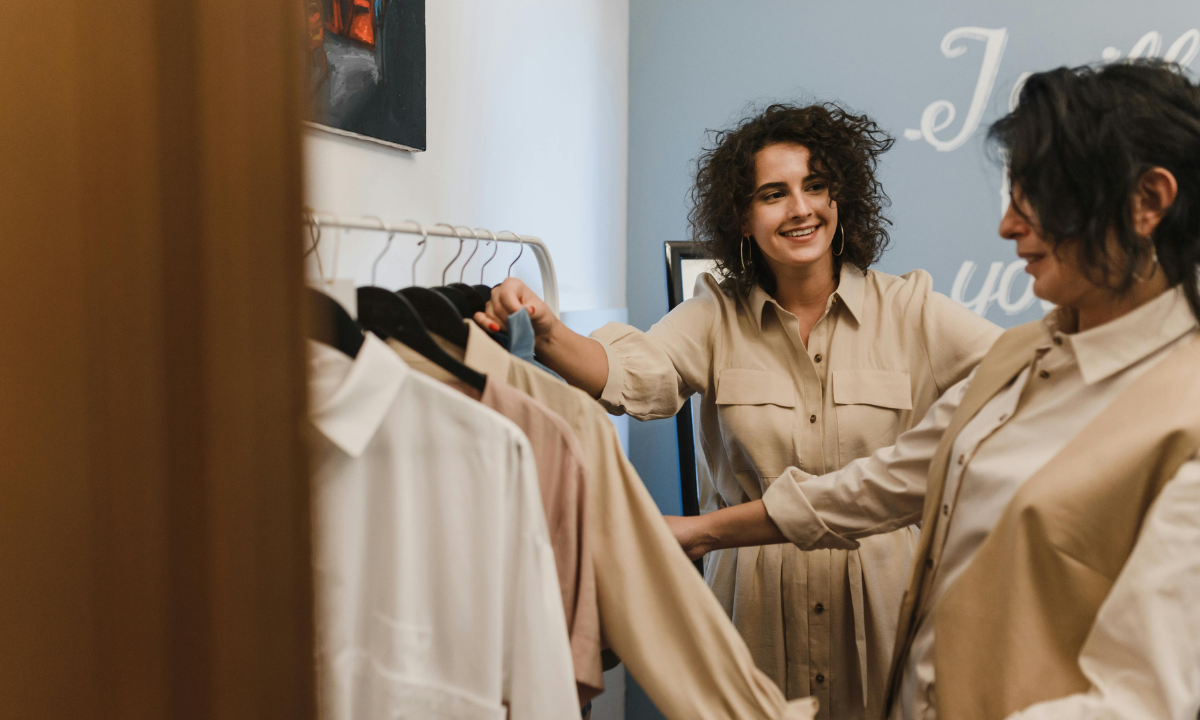Welcoming customers to your shop is a key factor in the success of your business. It goes far beyond a simple hello or a smile at the entrance. The way you welcome your customers has an impact on customer satisfaction, customer loyalty and even sales growth. Your customers form an opinion within the first few seconds. This first impression can have a lasting influence on their buying behaviour.
Why is good in-store customer service so important?
Why is good in-store customer service so important?
It’s a well-known fact in psychology: we form an opinion about a person or a place in a matter of seconds. This judgement, often unconscious, will influence the rest of the interaction.
The impact of non-verbal communication
Without even saying a word, your customer has already formed an opinion. The cleanliness of the shop, the way the shelves are organised, the lighting, the attitude of your sales assistants (are they slumped over behind their cash register, scrolling through their phones?) All these little details send out a signal. A successful customer reception starts with a well-kept environment and a team that projects a warm, positive image.
The 4×20 rule for a good welcome
The 4×20 rule perfectly underlines the importance of the first few moments. The first 20 seconds, the first 20 steps, the first 20 centimetres and the first 20 words are decisive. When you have to greet customers in-store, it’s vital not to miss these first moments, otherwise you’ll have to work hard to reverse a negative first impression.C’est un fait connu en psychologie : nous nous forgeons une opinion sur une personne ou sur un lieu en quelques secondes. Ce jugement, souvent inconscient, va influer sur toute la suite de l’interaction.
Satisfaction and loyalty, the role of the emotional bond
Your customer may be satisfied without being loyal to your brand. Loyalty stems from a deeper connection, an emotional bond. This is precisely what a good welcome to customers in shop is all about.
By making your customers feel recognised, valued and understood, you’re not just selling them an item. You’re selling them a positive experience that encourages them to return. This loyal customer will spend more, more often and will be less sensitive to the competition.
The impact of customer care on the average shopping basket
A well-received customer is a customer who stays longer in the shop. They are more open to discovery and more receptive to advice.
- Additional sales: A good welcome enables your sales assistant to create a bond with your customer. This will make it easier for them to sell complementary products (cross-selling) or move upmarket (up-selling).
- Conversion: A hesitant or curious visitor can be converted into a buyer by the simple intervention of an advisor who has approached them at the right time and in the right way.
The advantage of customer service over e-commerce
Why do customers make the effort to visit a shop when they could order online? For the human contact. It’s your number one competitive advantage. The welcome, the advice, the sincere exchanges are the points that enable shops to stand up to the e-commerce giants.
76% of French people cite the relationship with sales staff as the main reason for visiting a shop. (Samsung Smart Retail 2025 Barometer)
How can you assess your current customer reception?

Put yourself in your customer’s shoes
This is the most effective exercise. Walk into your shop as if it were the first time, or ask someone you know to do it for you.
- How long before someone greets you?
- Is the greeting accompanied by eye contact and a smile?
- Have you been offered help?
- Is the general atmosphere pleasant (cleanliness, smell, music, etc.)?
- How is the wait at the cash register?
- Is the departure as tidy as the arrival?
There are also companies that specialise in sending out mystery shoppers to carry out surveys to assess customer service in shops.
Ask for feedback
Your customers are your best source of information. Put simple tools in place to gather their opinions: a suggestion box, a QR code for a satisfaction questionnaire, by asking the question at checkout. Any feedback, even negative, is an opportunity for improvement.
Analyse your performance indicators
It’s important to analyse your store’s statistics. Some of the data may reveal problems with your in-store reception.
- Conversion rate: If a lot of people come in but few buy, there’s a problem. The customer welcome may be the cause.
- Bounce rate (physical): Look at the number of people who turn back a few moments after entering the store. This is an alarming sign.Il est important d’analyser les statistiques de votre commerce. Certaines données peuvent révéler des problèmes liés à l’accueil en magasin.
How to welcome a customer in-store? Our 5 tips

01 – Train and develop your teams
Vos collaborateurs sont en première ligne. Formez-les sur des bases concrètes : La règle des 4×20, l’écoute active, à préparer des questions ouvertes comme “Que recherchez-vous aujourd’hui ?” plutôt que “Je peux vous aider” ? Apprenez-leur également à gérer les objections et les clients difficiles.
Il est très important de savoir lire son client. Est-il pressé ? A t-il besoin d’être rassuré ? Veut-il regarder en paix ? Développer l’empathie et l’intelligence émotionnelle de vos équipes leur permettra d’adapter leur approche à chaque individu, pour un service personnalisé.
02 – Look after your shop’s environment
L’accueil commence avant même la première interaction humaine. L’environnement doit être pensé afin de mettre rapidement à l’aise votre client potentiel.
Un magasin propre et bien rangé est perçu comme plus professionnel et digne de confiance. Des allées dégagées, des produits bien présentés et une propreté irréprochable sont indispensables. Aidez vos clients à se repérer. Un parcours d’achat logique, une signalétique claire et un merchandising qui met en valeur les produits facilitent l’expérience et réduisent la frustration.
Le marketing sensorielle est un outil puissant. Une musique adaptée au positionnement de votre marque, une signature olfactive agréable et un éclairage soigné peuvent radicalement transformer la perception de votre magasin et influencer positivement l’humeur des clients.
Le décor, le design et l’ambiance sont le 3ème critère qui incitent le plus à visiter un point de vente, pour 67% des français. (Baromètre Samsung Smart Retail 2025)
03 – Work on customer reception from entry to exitSBAM
Structure the customer journey so that no stage is left to chance. To do this, remember to use the SHGTY method: Smile, Hello, Goodbye, Thank you. Customers should be greeted within 20 to 30 seconds of entering the store. The greeting should be warm, with eye contact. After greeting the customer in-store, give them a few moments to breathe. Observe their behaviour. If they seem to be looking for something, approach them with an open question.
The experience should be perfect right to the end, with smooth checkout to minimise queues at the cash register. The exit is your last chance to leave a memorable impression. A simple “Thank you for visiting. Have a great day and see you soon” leaves a final positive impression on your customer, who will be more inclined to return to your store.
04 – Offer the ‘little extra’ that makes all the difference
It may seem like nothing, but offering a little extra something can make all the difference. These are generally small, simple gestures that leave a lasting impression and have a major impact on customer loyalty.
For example, you could offer a coffee or glass of water, or a sample to slip into the bag or at the checkout. Some brands also offer small free services, such as a gift-wrapping service. Don’t forget to mention your loyalty scheme or offer personalised discounts. These are simple things that show you really care about your customer’s well-being.
05 – Personalise your customer welcome
As a retailer, making your customer feel recognised and understood is the most powerful lever you have at your disposal. The simplest and most effective form of personalisation is the use of your customer’s name. According to the psychologist Dale Carnegie, a person’s name is the sweetest and most important sound there is.
Beyond the name, you can take personalisation a step further by incorporating your customer’s history and tastes. This way, you’ll be in a better position to provide personalised advice that really speaks to your customer. They’ll feel that their needs and preferences are understood, which will encourage them to come back to you.
Not everyone has the memory to remember everything. No problem, these days there are solutions to overcome this problem. Cash register software such as RoverCash has customer loyalty features that allow you to create complete customer files to centralise all the essential information about your customers, as well as their entire purchase history.
What you need to know about welcoming customers in-store
Improving the way you welcome customers in-store is a long-term investment in customer relations. It often doesn’t cost much, but the benefits can be enormous: satisfaction, loyalty, brand awareness and sales performance.
Customers need to be considered, understood and supported. And that starts right from the first moment they enter your shop. Start today: choose just one of the approaches mentioned and put it into practice. The results won’t be long in coming.


